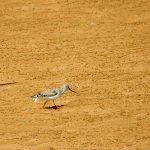TEREK SANDPIPER
The Terek Sandpiper is a visitor to the Australian landscape, primarily during the warmer months. These birds embark on an impressive journey from their breeding grounds in the taiga and tundra regions of northern Eurasia to the coastal areas of Australia. Despite their long migratory journeys, Terek Sandpipers exhibit remarkable site fidelity, often returning to the same locations year after year.
In Australia, they are predominantly found along the northern and eastern coastlines, frequenting estuaries, mudflats, and sandy beaches. These habitats provide the perfect foraging grounds for the sandpipers, offering an abundance of food and a safe haven during their stay.
The breeding season of the Terek Sandpiper takes place back in the northern reaches of Eurasia, where the daylight lingers for most of the day during the summer months. They nest on the ground, often near water, where the female lays typically 3-4 eggs. Both parents share the responsibility of incubating the eggs and caring for the chicks once they hatch. The nurturing of their young is a testament to the sandpiper’s dedication and resilience, ensuring the continuation of their species.
Terek Sandpipers are opportunistic feeders with a diet that primarily consists of small invertebrates. Their long, upturned bills are perfectly adapted for probing into the sand and mud, allowing them to extract worms, crustaceans, and insects. This unique feeding behavior is not only fascinating to observe but is also crucial for the ecosystem, as it helps in the aeration of the soil and the control of insect populations. Their upturned bill is not just a tool for feeding but also a distinctive feature that makes them easily recognizable among other shorebirds.
Like many migratory birds, Terek Sandpipers face numerous threats along their migratory routes and in their habitats. Habitat loss due to coastal development, pollution, and human disturbance are significant challenges. Additionally, climate change poses a long-term threat by altering the coastal ecosystems they depend on for feeding and resting. Conservation efforts are paramount to ensure the survival of these remarkable birds.
The Terek Sandpiper is named after the Terek River in the Caucasus, highlighting the connection between their migratory paths and geographical landmarks.
The Terek Sandpiper’s journey from the northern tundras to the shores of Australia is a compelling story of survival, adaptation, and the interconnectedness of our global ecosystems. By understanding and appreciating these birds, we are reminded of the beauty of nature’s cycles and the importance of conserving the habitats that support such incredible biodiversity. Let’s cherish and protect these avian travelers, for they are not just visitors but vital parts of the ecological tapestry that enriches our planet.



